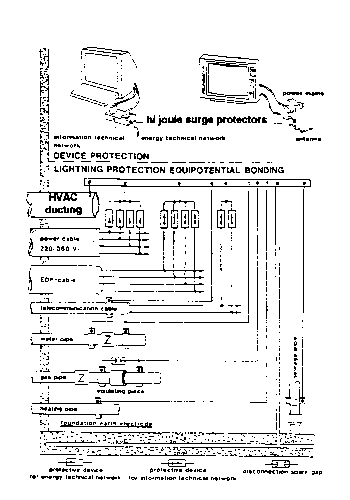![]()
~ National Lightning Safety Institute ~
|
|
|
|
~ National Lightning Safety Institute ~ |
|
|
Section 5.2.2 Overvoltages: Cause, Effect & MitigationBy Richard Kithil, President & CEO I. Summary. The installed base of electronic control, data, and measurement devices is growing very quickly. Overvoltage problems to these electronic components also have increased steadily in recent times. Codes and standards in the US including NFPA 780, UL96, and the NEC do not describe adequate protection levels for modern day situations and technologies. II. Source of Harmful Overvoltages. Electrical and electronic equipment are susceptible to disruption by direct lightning strokes, by ESD (electrostatic discharges), by LEMP (lightning electromagnetic pulse), by NEMP (nuclear elecromagnetic pulse), and by SEMP (switching electromagnetic pulse). In the literature (Krider) there is evidence that typical distance from lightning Strike A to Strike B to Strike C, etc. is an order of 1-3 km. A ground current transfer can radiate to 1-3 km from strike center, depending on impedance factors, soil composition/pH, and other variables. The lightning safety engineer should consider ohmic coupling, inductive coupling and capacitive coupling situations in overvoltage analysis. III. Design Options. The most common lightning protection to structures is external in design. Lightning rods, downconductor wires, and ground rods incorporate the typical approach. In some situations, this configuration may be harmful, inadequate or even unnecessary. Air terminals, for example, on a munitions bunker or on a golf course rain shelter may lead to problems rather than to solutions. Not-so-common external configurations may include catenary screening and other partial Faraday designs. Finally, there are a number of unsubstantiated arrays such as the so called "dissipators" and "streamer modification" products. Caveat emptor.

Internal lightning protection systems also are vital to a comprehensive lightning safety approach. Figure 1 , above, diagrams this concept in a representative schematic. Energy and information devices are bonded in common. Isolating spark gaps are connected to all conductive routings which penetrate the structure. Large industrial projects may contain a complex interconnect of cables, conduits, ducts, pipes and wiring including water lines, gas pipes, heating pipes, fire extinguisher pipes, elevator rails and railroad tracks, crane frames, ventilation and air-conditioning ductwork, buried rebar, power cables, telecomm & data lines, antenna and coaxial cables, auxiliary grounding rods, screening conductors, CCTV security cables, etc. Good practice suggests total connectivity for assured potential equalization and protection against induced overvoltages. Optoelectronic connections should be considered where appropriate, including situations where galvanic issues require treatment. IV. Conclusion. A system-wide comprehensive lightning safety analysis is recommended during the design stage. Overvoltage treatments should be considered at this time. Such concepts as totally screened internal cages or rebar interconnectivity for external shielding are difficult to achieve after occupancy. Contemporary engineering makes it possible to protect low voltage systems and highly sensitive electronic devices during most overvoltage situations. |